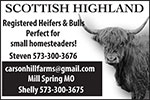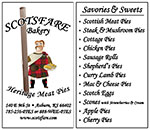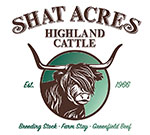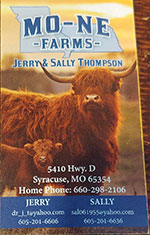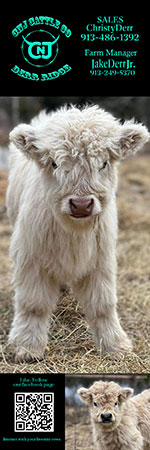2025 Spring Highland Cattle Auction Sponsors:
|
The Heartland Highland Cattle Association was founded in 1994 to promote the Highland Cattle breed. After displaying Highlands at agricultural events, county fairs, and Scottish festivals, it was evident that very few people were familiar with the Scottish Highland Cattle breed.
In 2019 the Heartland Highland Cattle Association added the Highland Cattle Registry to the association. At that time the HHCA also compiled the first and only Highland Breed Standards in the United States for Scottish and American Highland Cattle.
The HHCA Registry is an OPEN Registry for Scottish and American Highland cattle. This gives Highland Breeders the opportunity to compare their Highlands to the Breed Standard and register their Highlands as Foundation Stock.
Besides the open registry, the HHCA purpose is to provide information and support to the people who are interested in the Highland breed. There is an informational packet available to anyone interested in learning about the breed, first-time cattle breeders, the small producer, the beef producer, or all-natural meat producers.
There are numerous benefits for members to assist them in being successful Highland breeders and marketers. HHCA provides the following:
- A website at www.heartlandhighlandcattleassociation.org
- A free 3-month ad in the Classified Ad section on the website
- Highland Journal quarterly HHCA official publication
- Membership name on website directory
- Yearly membership directory
- Link to HHCA website at no cost
- Networking to sell or purchase animals available by contacting HHCA Secretary
- Annual meeting and gathering the first weekend in March in Branson, MO
- Largest Highland Cattle auction each spring and fall in southwest Missouri since 2012
- Auction website www.highlandauction.com
- Beef Marketing page on website for members
- Updated Classified Ad section on website weekly
- Annual summer HHCA picnic
- Free information packet to referrals inquiring about Highland Cattle
- Mass emails of upcoming events
- Free promotional information to members displaying at events
- Highland merchandise available for sale on website
- Paypal and credit cards accepted
- Check out the Heartland Highland Cattle Association Facebook group and page.
- Check out the HHCA Scottish Highland Cattle Auction Facebook group.
- Tax deductible dues (HHCA is a non-profit association with a 501 (c) 3)
- Membership is on a 12-month basis, with annual dues of $35
- The HHCA is governed by a seven-member Board of Directors.
- The HHCA hosts Highland events at members’ locations for networking.
The Heartland Highland Cattle Association and Registry is an association founded to promote the Scottish and American Highland cattle breed’s unique characteristics and to provide information and assistance to those people interested in the breed. In addition, the association and registry shall adhere to the Highland Breed Standards developed in 2019 by the Heartland Highland Cattle Association and Registry and assist breeders in the improvement of their folds.
HIGHLAND CATTLE
Reprinted from Countryside & Small Stock Journal By Lee Wolfgang
Why would you want to own something that looks like that?
It's a question many Highland Cattle owners have heard in the past. Here are some answers.
Highland cattle are the oldest registered breed of cattle with a Herd Book being published in 1885. The Scottish Highland Cattle Society was formed in 1884 and most of the cattle registered were black. Originally, there were two subgroups of Highland cattle, which today are merged into one. The smaller, mostly black or brindled cattle were raised on the western islands and were known as Kyloes, and the larger red animals of the Scottish mainland. Today Highland cattle may be red, black, yellow, white, brindle, silver, or dun in color. All these colors are recognized by the registry, but only solid colored animals are allowed to be shown in the sanctioned shows.
Archeological evidence of the Highland breed goes back to the 6 th century with written records existing from the 12 th century. The first recorded importation into the United States occurred in the late 1890's when western cattlemen recognized the need to improve the hardiness of their herds. Earlier importations are likely to have occurred since large numbers of Scotch/Irish immigrants came to this country early on, but the absence of a registry precludes any definite proof. The American Highland Cattle Association registry was formed in 1948. The reasons these ranchers selected Highland Cattle are the same reasons why you should consider the breed.
Breed characteristics that make the difference include:
Hardiness and vigor: Highland cattle are noted for their hardiness and vigor. Natural selection over the centuries in the harsh climate of Scotland ensured that only the most efficient animals would survive to breed. The gene pool today remains largely intact allowing them to thrive where other breeds struggle.
Hair Coat: The double coat of hair (long, coarse, outer layer and soft wooly inner layer) is one of the most notable differences between Highlands and all other breeds. The coat reduces the need for expensive barns and shelters. It is not unusual to see Highlands grazing a day or two after a winter storm with snow still melting off their backs as they are that well insulated. The long hair over the eyes (dossan) helps reduce the incidence of pinkeye and other fly borne problems.
According to one breeder, Highlands feed intake does not increase until -18 degrees F compared to 32 degrees F in many other breeds. In addition, the long hair means that the animal does not have to produce a layer of fat to stay warm. This allows the animal to marble naturally on low input forage while producing lean, low fat, high quality cuts of beef. Highlands shed out earlier in the spring and produce less hair in warm climates making them suitable throughout the U.S.
Easy Handling: Highlands have a long, close history of living with humans. Early Scots would keep the cows downstairs to provide warmth for the family on the second story and to make sure the neighbors didn't help themselves to the family's wealth. Highlands tend to be docile and calm, do not stress easily, and are easy to work with despite their long horns. The horns are used primarily for knocking down brush to graze on, predator control and scratching. Horns on females are generally upswept and finer textured than are the males. Male horns are more forward pointing and massive.
Exceptional Mothering-Calving Ease: Highland cows are noted for being highly devoted and protective mothers. They produce a rich milk allowing for steady weight gain in the calf. Highlands are noted for calving ease. Calves are small, 40-60 pounds and birthing assists are rare. Cows may produce into their late teens reducing the need for frequent herd replacements.
Unlike other breeds, Highlands are slow maturing making the meat fine textured and succulent. In a recent study at Manyberries Research Station, Canada , groups of Hereford , Highland , and Highland Herefords crosses were tested. The Highland group produced 2,000 pounds more beef than the purebred Herefords, while the Highland/Hereford crosses produced 6,000 pounds more than the pure Hereford group.
Highland cows will average 900-1,200 pounds when mature. Bulls will average from 1,500 to 2,000 pounds depending on forage conditions. A study by the Scottish Agricultural College determined that Highland beef is significantly lower in fat and cholesterol and higher in protein and iron than other beef breeds.
The British Royal family maintains a “fold” of Highland Cattle at Balmoral Castle and considers them their beef animal of choice. A rare opportunity for commoners to eat like royalty.
Highland Cattle Societies are found in Great Britain ( Scotland ), United States , Canada , Australia , and several European Countries. The animals are referred to as Scottish Highland Cattle, Scotch Highland Cattle, Highland Cattle or Highlanders. Regardless of where they are located today, Highland cattle can trace their ancestry to Scotland . Importations of Scottish stock and semen in the U.S. and Canada have served to assure continuation of the Highland gene pool.
Highland cattle provide the opportunity to produce a premium quality beef with less cost and effort. They fit into a variety styles of operations from small farm to commercial beef operations. They are a multi-purpose animal, producing meat, milk, and fiber. They may be used as oxen, or for clearing land of unwanted brush or you may just want the enjoyment of seeing a beautiful animal on your hillside pasture.
So when someone asks, “why do you want to own something that looks like that?” I generally respond by saying who wouldn't want to?
For a free informational packet on Highland cattle, you may contact the Heartland Highland Cattle Association at 976 State Hwy. 64, Tunas, MO 65764 or call 417.345.0575 or email heartlandhighlandcattle@gmail.com




